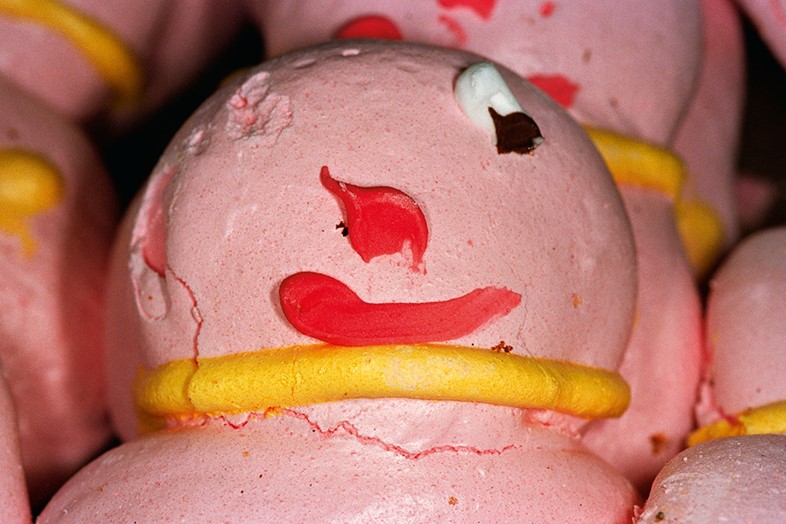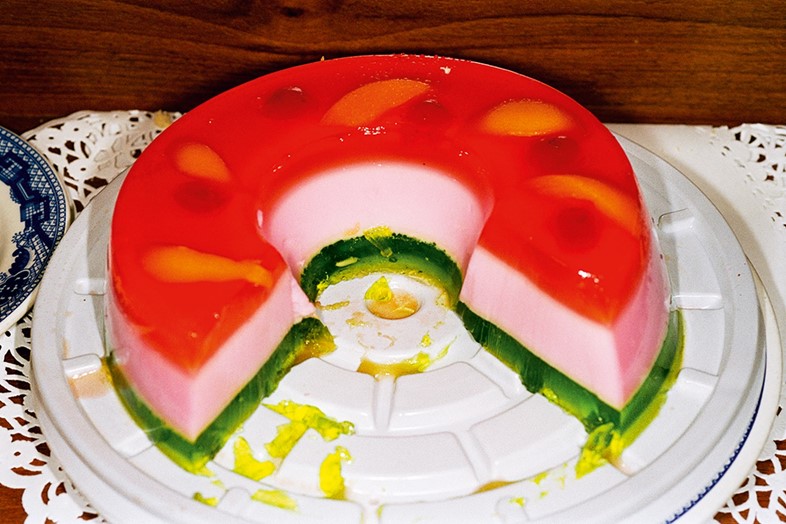What can you tell about a person from the food they eat? Martin Parr’s fun new photo-book, Real Food, examines the socio-cultural context of a selection of global dishes
Martin Parr operates from an idiosyncratic place in the photography industry. His work bridges the gap between the fine artist, filling the walls of esteemed galleries, and documentary photographer who operates through an agency, releasing an opus of books charting social observations. Like any image-maker seeking to truly document real life, his pictures aren’t staged – rather he pops into a situation, clicks his camera, and as quickly as he arrived, he vanishes. He takes hundreds of images, whittles them down to a handful, and then releases them in the form of an artist’s photo-book on each subject he tackles. They are always brimming with his voracious intrigue and produce a witty, yet deep-rooted cultural critique.
Parr’s wealth of photo-books is testament to his obsession with observation – he is constantly working, like a hunter of images who thrives on spotting metaphors in the mundane. For generations people have tried to pinpoint the themes in his work, which is often cited as chintzy or tacky, but in reality there are two levels to it. On the outset his photographs seem to document cultural identity – British bank holiday beach trips in the rain, cups of tea in builder’s cafes, or Conservative Party soirees. These snapshots are a tongue-in-cheek observation on British eccentricity, brimming with what is so often regarded as twee and tasteless. But scratch the surface, and something very clever is happening. Parr’s work is an anthropological study: it shows the rituals people undertake, the groups they chose to join, the choices they make about how to spend their time and money. And in this new tome, what they choose to eat.

Culinary choices, picked up on so lightheartedly by Parr, speak volumes about the diner – a figure who remains obscured by the photographer throughout his process. Chips and gravy with a plastic fork, ambiguous vacuum-packed meat on a stick, pitta breads drying on a Middle Eastern taxi roof – these are all images of what, where and how people choose to dine, snapshots of social gatherings, celebratory meals and local produce fairs, or simply 'a treat'. They show the local population at their truest, observing their hearts through their stomach.
As is often the case with Parr, the photographs which make up Real Food feel dated, as if from some classless, tasteless bygone era of kitsch that no longer exists. This is a body of work spanning the decades from the 80s until the present day, and as such the resulting images feel soaked in a historical irony. In reality, however, scenes like these still take place around the world – in seaside towns, grandparents' houses, American theme parks and Arabian markets – anywhere people gather for fun and food. What the wily photographer is in fact doing is transforming his viewer into a kind of subjective judge; as we try to unravel the image, guessing the location, the occasion and the class of its subject, we are simultaneously creating a narrative about the characters in it, based on their snack of choice. A paradigm forms in which each snapshot expands to become a part of a wider context in our minds, something like a 'guess who' book of nationalities where every clue is a meal. Parr has even generously placed a small index of the location of each photograph at the back of the book, enabling us to fact-check our guesses afterwards.

The images in Real Food lose none of Parr’s charm through the absence of human subject – bright and tightly cropped, they retain the signature irreverence and irony that he has become synonymous with. The book celebrates the sugar-filled gluttonous children, the local fresh fruit, the award-winning pie and the local delicacies of foreign markets in all their glory. An introductory essay by Fergus Henderson, the British chef who founded St. John in London, sets the scene for Parr’s examination of global cuisine, and establishes the social context of food in all its fascinating glory. You’ll never look at a hot dog the same way again.
Real Food by Martin Parr is available now, published by Phaidon.
